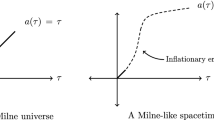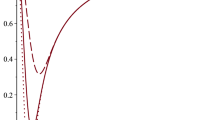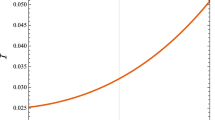Abstract
The final ringdown phase in a coalescence process is a valuable laboratory to test General Relativity and potentially constrain additional degrees of freedom in the gravitational sector. We introduce here an effective description for perturbations around spherically symmetric spacetimes in the context of scalar-tensor theories, which we apply to study quasi-normal modes for black holes with scalar hair. We derive the equations of motion governing the dynamics of both the polar and the axial modes in terms of the coefficients of the effective theory. Assuming the deviation of the background from Schwarzschild is small, we use the WKB method to introduce the notion of “light ring expansion”. This approximation is analogous to the slow-roll expansion used for inflation, and it allows us to express the quasinormal mode spectrum in terms of a small number of parameters. This work is a first step in describing, in a model independent way, how the scalar hair can affect the ringdown stage and leave signatures on the emitted gravitational wave signal. Potential signatures include the shifting of the quasi-normal spectrum, the breaking of isospectrality between polar and axial modes, and the existence of scalar radiation.
Article PDF
Similar content being viewed by others
Avoid common mistakes on your manuscript.
References
LIGO Scientific and Virgo collaborations, Observation of gravitational waves from a binary black hole merger, Phys. Rev. Lett. 116 (2016) 061102 [arXiv:1602.03837] [INSPIRE].
LIGO Scientific and Virgo collaborations, GW151226: observation of gravitational waves from a 22-solar-mass binary black hole coalescence, Phys. Rev. Lett. 116 (2016) 241103 [arXiv:1606.04855] [INSPIRE].
LIGO Scientific and Virgo collaborations, GW170817: observation of gravitational waves from a binary neutron star inspiral, Phys. Rev. Lett. 119 (2017) 161101 [arXiv:1710.05832] [INSPIRE].
S. Endlich, V. Gorbenko, J. Huang and L. Senatore, An effective formalism for testing extensions to general relativity with gravitational waves, JHEP 09 (2017) 122 [arXiv:1704.01590] [INSPIRE].
I.Z. Rothstein, TASI lectures on effective field theories, hep-ph/0308266 [INSPIRE].
E. Berti, V. Cardoso and C.M. Will, On gravitational-wave spectroscopy of massive black holes with the space interferometer LISA, Phys. Rev. D 73 (2006) 064030 [gr-qc/0512160] [INSPIRE].
E. Berti, K. Yagi, H. Yang and N. Yunes, Extreme gravity tests with gravitational waves from compact binary coalescences: (II) ringdown, Gen. Rel. Grav. 50 (2018) 49 [arXiv:1801.03587] [INSPIRE].
S. Bhattacharyya and S. Shankaranarayanan, Quasinormal modes as a distinguisher between general relativity and f (R) gravity, Phys. Rev. D 96 (2017) 064044 [arXiv:1704.07044] [INSPIRE].
S. Bhattacharyya and S. Shankaranarayanan, Quasinormal modes as a distinguisher between general relativity and f (R) gravity: charged black-holes, Eur. Phys. J. C 78 (2018) 737 [arXiv:1803.07576] [INSPIRE].
E. Barausse, V. Cardoso and P. Pani, Can environmental effects spoil precision gravitational-wave astrophysics?, Phys. Rev. D 89 (2014) 104059 [arXiv:1404.7149] [INSPIRE].
E. Winstanley, Dressing a black hole with non-minimally coupled scalar field hair, Class. Quant. Grav. 22 (2005) 2233 [gr-qc/0501096] [INSPIRE].
J.D. Bekenstein, Nonexistence of baryon number for static black holes, Phys. Rev. D 5 (1972) 1239 [INSPIRE].
J.D. Bekenstein, Novel “no-scalar-hair” theorem for black holes, Phys. Rev. D 51 (1995) R6608 [INSPIRE].
L. Hui and A. Nicolis, No-hair theorem for the Galileon, Phys. Rev. Lett. 110 (2013) 241104 [arXiv:1202.1296] [INSPIRE].
H. Dennhardt and O. Lechtenfeld, Scalar deformations of Schwarzschild holes and their stability, Int. J. Mod. Phys. A 13 (1998) 741 [gr-qc/9612062] [INSPIRE].
T.P. Sotiriou and S.-Y. Zhou, Black hole hair in generalized scalar-tensor gravity: an explicit example, Phys. Rev. D 90 (2014) 124063 [arXiv:1408.1698] [INSPIRE].
G. Antoniou, A. Bakopoulos and P. Kanti, Black-hole solutions with scalar hair in Einstein-scalar-Gauss-Bonnet theories, Phys. Rev. D 97 (2018) 084037 [arXiv:1711.07431] [INSPIRE].
D.D. Doneva and S.S. Yazadjiev, New Gauss-Bonnet black holes with curvature-induced scalarization in extended scalar-tensor theories, Phys. Rev. Lett. 120 (2018) 131103 [arXiv:1711.01187] [INSPIRE].
H.O. Silva, J. Sakstein, L. Gualtieri, T.P. Sotiriou and E. Berti, Spontaneous scalarization of black holes and compact stars from a Gauss-Bonnet coupling, Phys. Rev. Lett. 120 (2018) 131104 [arXiv:1711.02080] [INSPIRE].
T. Jacobson, Primordial black hole evolution in tensor scalar cosmology, Phys. Rev. Lett. 83 (1999) 2699 [astro-ph/9905303] [INSPIRE].
E. Berti, V. Cardoso, L. Gualtieri, M. Horbatsch and U. Sperhake, Numerical simulations of single and binary black holes in scalar-tensor theories: circumventing the no-hair theorem, Phys. Rev. D 87 (2013) 124020 [arXiv:1304.2836] [INSPIRE].
M.W. Horbatsch and C.P. Burgess, Cosmic black-hole hair growth and quasar OJ 287, JCAP 05 (2012) 010 [arXiv:1111.4009] [INSPIRE].
C.A.R. Herdeiro and E. Radu, Asymptotically flat black holes with scalar hair: a review, Int. J. Mod. Phys. D 24 (2015) 1542014 [arXiv:1504.08209] [INSPIRE].
O.J. Tattersall, P.G. Ferreira and M. Lagos, Speed of gravitational waves and black hole hair, Phys. Rev. D 97 (2018) 084005 [arXiv:1802.08606] [INSPIRE].
LIGO Scientific, Virgo, Fermi-GBM and INTEGRAL collaborations, Gravitational waves and gamma-rays from a binary neutron star merger: GW170817 and GRB170817A, Astrophys. J. 848 (2017) L13 [arXiv:1710.05834] [INSPIRE].
C. de Rham and S. Melville, Gravitational rainbows: LIGO and dark energy at its cutoff, Phys. Rev. Lett. 121 (2018) 221101 [arXiv:1806.09417] [INSPIRE].
T.P. Sotiriou, Black holes and scalar fields, Class. Quant. Grav. 32 (2015) 214002 [arXiv:1505.00248] [INSPIRE].
J.L. Blázquez-Salcedo, F.S. Khoo and J. Kunz, Quasinormal modes of Einstein-Gauss-Bonnet-dilaton black holes, Phys. Rev. D 96 (2017) 064008 [arXiv:1706.03262] [INSPIRE].
LIGO Scientific and Virgo collaborations, Search for tensor, vector and scalar polarizations in the stochastic gravitational-wave background, Phys. Rev. Lett. 120 (2018) 201102 [arXiv:1802.10194] [INSPIRE].
L. O’Beirne and N.J. Cornish, Constraining the polarization content of gravitational waves with astrometry, Phys. Rev. D 98 (2018) 024020 [arXiv:1804.03146] [INSPIRE].
T. Damour and G. Esposito-Farese, Gravitational wave versus binary-pulsar tests of strong field gravity, Phys. Rev. D 58 (1998) 042001 [gr-qc/9803031] [INSPIRE].
E. Barausse, C. Palenzuela, M. Ponce and L. Lehner, Neutron-star mergers in scalar-tensor theories of gravity, Phys. Rev. D 87 (2013) 081506 [arXiv:1212.5053] [INSPIRE].
B. Finelli, G. Goon, E. Pajer and L. Santoni, Soft theorems for shift-symmetric cosmologies, Phys. Rev. D 97 (2018) 063531 [arXiv:1711.03737] [INSPIRE].
B. Finelli, G. Goon, E. Pajer and L. Santoni, The effective theory of shift-symmetric cosmologies, JCAP 05 (2018) 060 [arXiv:1802.01580] [INSPIRE].
E. Babichev, C. Charmousis and A. Lehébel, Asymptotically flat black holes in Horndeski theory and beyond, JCAP 04 (2017) 027 [arXiv:1702.01938] [INSPIRE].
M. Minamitsuji and H. Motohashi, Stealth Schwarzschild solution in shift symmetry breaking theories, Phys. Rev. D 98 (2018) 084027 [arXiv:1809.06611] [INSPIRE].
S. Chandrasekhar, The mathematical theory of black holes, Clarendon, Oxford, U.K. (1985) [INSPIRE].
C. Cheung, P. Creminelli, A.L. Fitzpatrick, J. Kaplan and L. Senatore, The effective field theory of inflation, JHEP 03 (2008) 014 [arXiv:0709.0293] [INSPIRE].
B.F. Schutz and C.M. Will, Black hole normal modes: a semianalytic approach, Astrophys. J. 291 (1985) L33 [INSPIRE].
S. Iyer and C.M. Will, Black hole normal modes: a WKB approach. 1. Foundations and application of a higher order WKB analysis of potential barrier scattering, Phys. Rev. D 35 (1987) 3621 [INSPIRE].
J. Martin and D.J. Schwarz, WKB approximation for inflationary cosmological perturbations, Phys. Rev. D 67 (2003) 083512 [astro-ph/0210090] [INSPIRE].
R. Kase, L. Á. Gergely and S. Tsujikawa, Effective field theory of modified gravity on the spherically symmetric background: leading order dynamics and the odd-type perturbations, Phys. Rev. D 90 (2014) 124019 [arXiv:1406.2402] [INSPIRE].
O.J. Tattersall, P.G. Ferreira and M. Lagos, General theories of linear gravitational perturbations to a Schwarzschild black hole, Phys. Rev. D 97 (2018) 044021 [arXiv:1711.01992] [INSPIRE].
O.J. Tattersall and P.G. Ferreira, Quasinormal modes of black holes in Horndeski gravity, Phys. Rev. D 97 (2018) 104047 [arXiv:1804.08950] [INSPIRE].
J. Ben Achour, D. Langlois and K. Noui, Degenerate higher order scalar-tensor theories beyond Horndeski and disformal transformations, Phys. Rev. D 93 (2016) 124005 [arXiv:1602.08398] [INSPIRE].
L. Senatore and M. Zaldarriaga, The effective field theory of multifield inflation, JHEP 04 (2012) 024 [arXiv:1009.2093] [INSPIRE].
T. Regge and J.A. Wheeler, Stability of a Schwarzschild singularity, Phys. Rev. 108 (1957) 1063 [INSPIRE].
P. Creminelli, M.A. Luty, A. Nicolis and L. Senatore, Starting the universe: stable violation of the null energy condition and non-standard cosmologies, JHEP 12 (2006) 080 [hep-th/0606090] [INSPIRE].
S. Alexander and N. Yunes, A new PPN parameter to test Chern-Simons gravity, Phys. Rev. Lett. 99 (2007) 241101 [hep-th/0703265] [INSPIRE].
C. Molina, P. Pani, V. Cardoso and L. Gualtieri, Gravitational signature of Schwarzschild black holes in dynamical Chern-Simons gravity, Phys. Rev. D 81 (2010) 124021 [arXiv:1004.4007] [INSPIRE].
D. Langlois, M. Mancarella, K. Noui and F. Vernizzi, Effective description of higher-order scalar-tensor theories, JCAP 05 (2017) 033 [arXiv:1703.03797] [INSPIRE].
A. Nicolis, R. Rattazzi and E. Trincherini, The Galileon as a local modification of gravity, Phys. Rev. D 79 (2009) 064036 [arXiv:0811.2197] [INSPIRE].
G.W. Horndeski, Second-order scalar-tensor field equations in a four-dimensional space, Int. J. Theor. Phys. 10 (1974) 363 [INSPIRE].
C. Deffayet, X. Gao, D.A. Steer and G. Zahariade, From k-essence to generalised Galileons, Phys. Rev. D 84 (2011) 064039 [arXiv:1103.3260] [INSPIRE].
J.L. Blázquez-Salcedo et al., Perturbed black holes in Einstein-dilaton-Gauss-Bonnet gravity: stability, ringdown and gravitational-wave emission, Phys. Rev. D 94 (2016) 104024 [arXiv:1609.01286] [INSPIRE].
H. Witek, L. Gualtieri, P. Pani and T.P. Sotiriou, Black holes and binary mergers in scalar Gauss-Bonnet gravity: scalar field dynamics, arXiv:1810.05177 [INSPIRE].
V. Cardoso, E. Franzin and P. Pani, Is the gravitational-wave ringdown a probe of the event horizon?, Phys. Rev. Lett. 116 (2016) 171101 [Erratum ibid. 117 (2016) 089902] [arXiv:1602.07309] [INSPIRE].
V. Cardoso and P. Pani, The observational evidence for horizons: from echoes to precision gravitational-wave physics, arXiv:1707.03021 [INSPIRE].
S. Iyer, Black hole normal modes: a WKB approach. 2. Schwarzschild black holes, Phys. Rev. D 35 (1987) 3632 [INSPIRE].
V. Baibhav and E. Berti, Multimode black hole spectroscopy, Phys. Rev. D 99 (2019) 024005 [arXiv:1809.03500] [INSPIRE].
T. Kobayashi, H. Motohashi and T. Suyama, Black hole perturbation in the most general scalar-tensor theory with second-order field equations I: the odd-parity sector, Phys. Rev. D 85 (2012) 084025 [Erratum ibid. D 96 (2017) 109903] [arXiv:1202.4893] [INSPIRE].
S.H. Völkel, Inverse spectrum problem for quasi-stationary states, J. Phys. Commun. 2 (2018) 025029 [arXiv:1802.08684] [INSPIRE].
R.A. Konoplya, How to tell the shape of a wormhole by its quasinormal modes, Phys. Lett. B 784 (2018) 43 [arXiv:1805.04718] [INSPIRE].
A. De Felice, T. Suyama and T. Tanaka, Stability of Schwarzschild-like solutions in f (R, G) gravity models, Phys. Rev. D 83 (2011) 104035 [arXiv:1102.1521] [INSPIRE].
F.J. Zerilli, Effective potential for even parity Regge-Wheeler gravitational perturbation equations, Phys. Rev. Lett. 24 (1970) 737 [INSPIRE].
T. Kobayashi, H. Motohashi and T. Suyama, Black hole perturbation in the most general scalar-tensor theory with second-order field equations II: the even-parity sector, Phys. Rev. D 89 (2014) 084042 [arXiv:1402.6740] [INSPIRE].
G. Obied, H. Ooguri, L. Spodyneiko and C. Vafa, De Sitter space and the swampland, arXiv:1806.08362 [INSPIRE].
E. Barausse, N. Yunes and K. Chamberlain, Theory-agnostic constraints on black-hole dipole radiation with multiband gravitational-wave astrophysics, Phys. Rev. Lett. 116 (2016) 241104 [arXiv:1603.04075] [INSPIRE].
D. Baumann, D. Green, H. Lee and R.A. Porto, Signs of analyticity in single-field inflation, Phys. Rev. D 93 (2016) 023523 [arXiv:1502.07304] [INSPIRE].
G. Franciolini, L. Hui, R. Penco, L. Santoni and E. Trincherini, Stable wormholes in scalar-tensor theories, JHEP 01 (2019) 221 [arXiv:1811.05481] [INSPIRE].
G. Franciolini, L. Hui, R. Penco, L. Santoni and E. Trincherini, in preparation.
A. Nicolis and R. Rattazzi, Classical and quantum consistency of the DGP model, JHEP 06 (2004) 059 [hep-th/0404159] [INSPIRE].
D. Pirtskhalava, L. Santoni, E. Trincherini and F. Vernizzi, Weakly broken Galileon symmetry, JCAP 09 (2015) 007 [arXiv:1505.00007] [INSPIRE].
L. Santoni, E. Trincherini and L.G. Trombetta, Behind Horndeski: structurally robust higher derivative EFTs, JHEP 08 (2018) 118 [arXiv:1806.10073] [INSPIRE].
J. Gleyzes, D. Langlois, F. Piazza and F. Vernizzi, Essential building blocks of dark energy, JCAP 08 (2013) 025 [arXiv:1304.4840] [INSPIRE].
J. Gleyzes, D. Langlois, F. Piazza and F. Vernizzi, Exploring gravitational theories beyond Horndeski, JCAP 02 (2015) 018 [arXiv:1408.1952] [INSPIRE].
F.J. Zerilli, Gravitational field of a particle falling in a Schwarzschild geometry analyzed in tensor harmonics, Phys. Rev. D 2 (1970) 2141 [INSPIRE].
H.-P. Nollert, Quasinormal modes: the characteristic ‘sound’ of black holes and neutron stars, Class. Quant. Grav. 16 (1999) R159 [INSPIRE].
Open Access
This article is distributed under the terms of the Creative Commons Attribution License (CC-BY 4.0), which permits any use, distribution and reproduction in any medium, provided the original author(s) and source are credited.
Author information
Authors and Affiliations
Corresponding author
Additional information
ArXiv ePrint: 1810.07706
Rights and permissions
Open Access This article is licensed under a Creative Commons Attribution 4.0 International License, which permits use, sharing, adaptation, distribution and reproduction in any medium or format, as long as you give appropriate credit to the original author(s) and the source, provide a link to the Creative Commons licence, and indicate if changes were made.
The images or other third party material in this article are included in the article’s Creative Commons licence, unless indicated otherwise in a credit line to the material. If material is not included in the article’s Creative Commons licence and your intended use is not permitted by statutory regulation or exceeds the permitted use, you will need to obtain permission directly from the copyright holder.
To view a copy of this licence, visit https://creativecommons.org/licenses/by/4.0/.
About this article
Cite this article
Franciolini, G., Hui, L., Penco, R. et al. Effective field theory of black hole quasinormal modes in scalar-tensor theories. J. High Energ. Phys. 2019, 127 (2019). https://doi.org/10.1007/JHEP02(2019)127
Received:
Revised:
Accepted:
Published:
DOI: https://doi.org/10.1007/JHEP02(2019)127




